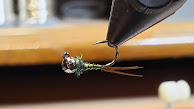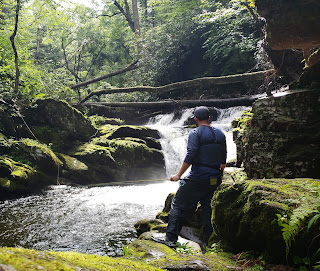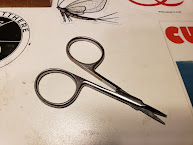In a world dominated by social media, more often people present the glossy and idealized version of their lives over the imperfect, gritty reality despite it being proven to be extremely unhealthy for all involved. This is no different in the fly fishing community on social media where the image of the 20-inch brown will always be presented to the world over the streamer snagged on a tree root after a failed bank cast. While failures on the water in all of their forms can be frustrating (hell, sometimes even maddening), they’re an important part of the learning process and given the impossibility of perfection, they’re here to stay. No matter how much an angler refines their skills, mistakes and miscalculations will always be made and it’s part of what makes life interesting.
Inspired by United Women on the Fly’s Mishap Monday initiative, I wanted to showcase some of the mistakes we all make on the water (though sometimes won’t admit), share some personal examples, and try to find the silver lining in all of it.
Falling
 |
| Gone too soon... |
It hurts and it’s embarrassing but everybody takes a spill every now and then on the water. The dents and scar tissue in my shins are a testament to that. Whether it’s due to studs slipping on smooth rock, not having studs, not planting feet firmly in fast water, or a million other possible catastrophes, falls happen and there’s no shame in owning them, learning from them, and (if you’re like me) replacing nets because you fell on them and shattered them. And yes, I said “nets” because it’s happened more than once.
I was once opposed to studs in my boots, thinking the grinding of metal on gravel would spook fish. I changed my tune, though, a few years ago on a below-freezing day when the lack of traction in a particularly fast current caused me to twist my ankle and fall in up to my neck. While hanging my waders upside-down from a tree to drain them, I made my decision to embrace studs. Since then I’ve been experimenting with different stud, spike, and aluminum bar combinations; I’ve found the Orvis PosiGrip studs to be my favorite, but really any small stud that doesn’t make me feel like I’m wearing platform shoes is a solid choice. However, even with the best studs, falls are still inevitable. After suffering a concussion ten years ago I have random moments when I lose my equilibrium and have to pause to get my bearings again, otherwise I’m going down.
Being mindful of surroundings while being patient and deliberate with each step is always a good approach, but I find that making sure to always wade against the current and have one’s stationary foot firmly planted when taking a step with the other will greatly reduce those tumbles into the stream.
Spooking Fish
There have been plenty of times when I’ve either seen feeding trout or come up to a particularly fishy section of water only to just completely spook anything that may have been there. Just last week I was stealthily creeping up to a favorite section of water while crouched and moving ever so slowly along a steep, rocky bank. Well, just as I planted my foot to make my first cast, I dislodged a rather large stone that slid down the bank and splashed violently into the water. A loud expletive later and I was moving on to the next spot.
Fishing small mountain streams for wild trout has taught me a lot about how not to spook fish, but it still happens. I’ve come across trout facing the opposite direction fifty-feet away only to spook them just by looking at them. However, fishing upstream, wearing drab clothing, approaching slowly and quietly (sometimes on hands and knees), only getting as close as is absolutely necessary, being mindful of water clarity and sunlight, and casting flies softly and accurately will help to reduce scaring off wary trout.
A final tip I’ll throw out in this area is to be subtle when removing flies from the water at the end of a drift. Many anglers just rip their flies out of the water and cast them back upstream, but if one waits until the end of the drift to slowly drag their rig over to the bank and then re-cast, they’ll spook fewer fish in the back end of a run.
Casting Into Trees
Almost as embarrassing as falling and just as inevitable is getting a fly stuck on a tree branch. Most often I find it happens when I’m over-excited about fishing a section and get sloppy, ultimately failing to notice the single branch hanging down over the run. There are plenty of other ways it happens, though, such as when trying to make a tight cast to the opposite bank and going just a few inches too far or hooking a branch on a back cast. However they occur, I’ve noticed they occur more in the colder months when there are no leaves on the trees and the individual branches are harder to see.
I’ve found that the best ways to reduce the frequency of sylvan snags is just to take a quick 360-degrees glance every time I set up in a new spot to be aware of your surroundings and then adjust my casting style accordingly, utilizing roll casts, bow-and-arrow casts, and water-loading as needed based on my surroundings.
Snagging
Snagging bottom is an inseparable part of nymphing and, to a slightly lesser extent, streamer fishing. Many times freeing a snag is just a matter of walking upstream a few steps and changing the angle of the rod, shifting the pressure and freeing the fly from whatever it’s stuck against, but sometimes it just has to be accepted that the fly (or flies) is gone. Every time I break off I find myself calculating not the cost of the fly, but the time it will take me to sit at the vise and re-tie it, which is a cost of its own kind. The only time I begrudgingly accept the idea of losing more than a few flies is when I nymph new water because I simply have no clue what’s down in those deeper pools unless I’m fishing it with someone else who possesses that knowledge.
There are occasions when I know the fly is hung up in less than two-feet of water and I’ll go get it. In these situations I keep moderate pressure applied with the rod tip and reel in as I step forward. Sometimes the snag will free itself before I’m even close enough to spook the fish and most times it will pop loose as the rod tip is directly over or just past the snag. Again, sometimes it’s just a matter of changing the angle of pressure. However, there are those rare times when just as my hand touches the water the fly comes free and the pressure from the rod tip slingshots it into an overhanging tree. The plethora of emotions the mind is capable of processing in a matter of seconds is astounding: first annoyance then elation, sheer horror, resignation, and finally defeat all in the blink of an eye.
If snagging feels like an all-too-ordinary aspect of one’s fly fishing experience, it may be time to think about the weight of the flies and shot being used. When nymphing, the goal is to achieve a natural drift with the point fly moving in the current just off the bottom while ticking bottom occasionally. If a nymph is dragging and dredging the stream bed completely, adjust the weight accordingly based on depth and current. Sometimes it may be necessary to alter a nymphing rig with each new section of water, but the results will usually be worth the effort.
No matter what, flies will be lost and one thing I’ve been working on is tying different knots to prevent breaking off entire rigs when one fly is snagged. On my Euro rig I use improved clinch knots on both ends of the tippet that goes from the sighter to my tippet ring. Then, when tying the point fly tippet and tag tippet to the ring I use triple Davy knots. Finally, when tying the tippet to the fly I use a double Davy knot. This combination has greatly helped to focus the breaking point on just the fly.
Fish Not Taking Flies
Even after avoiding all of the aforementioned calamities, sometimes fish just won’t take a fly for a number of reasons.
While fishing dries and nymphs, drag on the fly’s drift is a common cause for fish turning away. Not only can there be numerous rates of flow between banks, but the rate of flow also varies from the bottom to the surface. When dry fly fishing or indicator nymphing with line on the water, frequent mending is a necessity so the line on the water doesn’t get too far ahead of or behind the fly and causing it to drag unnaturally through the drift. When indicator nymphing, also try to keep both the flies and the indicator in the same current so the indicator doesn’t create drag. For this and many other reasons, I prefer Euro nymphing whenever possible, but even then it’s important to have the rod tip positioned so that the leader is as vertical as possible while maintaining a very slight amount of slack.
While I feel the previously mentioned elements of presentation are the most important factors, many times sunlight and water clarity play a significant part in a fish’s decision to pass up a fly. With the exception of specific hatches, my rule of thumb is typically this: the brighter the sun and the clearer the water, the smaller and more natural I’ll be leaning in my fly selection. The same goes for tippet. However, there is a belief in fly fishing that the fish has the final say and sometimes no matter how much work goes into presentation and fly selection, it’s just not going to happen and that’s okay.
Missing Hooksets
I’ll admit I have a complex about setting on dry fly takes. Euro nymphing has made my reflexes too quick and I often set too fast on dries and ruin opportunities for myself by yanking the fly out of the side of the trout’s mouth before the fish has had a chance to go under with it. Also, Euro nymphing involves no mending whatsoever and sometimes that slips my mind on the rare occasions when I find myself dry fishing on bigger water (usually when I’m out West).
One observation I had while both wading and drifting last summer in Wyoming and Idaho was that it’s much easier to set on a dry fly take from a drift boat than while wading. My position over the river rather than in it made mending easier and also made for a swifter upward motion of the rod tip leading the line to lift more smoothly from the water regardless of distance.
While nymphing, whether it be with a sighter or an indicator, the general rule is to set on everything. Trout sets are light and it’s often possible to continue the drift after setting on a rock and freeing the fly. I’ve missed plenty of hooksets while pondering whether the sudden pause in my sighter was a rock or a fish because nymph takes can be so subtle. That subtlety is especially prevalent on the swing, which is why I always set at the absolute end of my drift, especially when using a stonefly, micro-streamer, or leech as my point fly.
Fishing streamers is a relatively new area for me, but I’ve found that most of my missed hooksets are due to territorial fish nipping at the tail of the streamer rather than aggressively attacking it. I’m still working out ways to prevent this (other than the obvious option of using articulated streamers) but on days when this has been a frequent occurrence I’ve found success by either going a size or two smaller with my streamer or by slowing down my presentation altogether. Again, I’m still working that out.
Losing Fish
With a successful hookset there are no guarantees to landing a fish. So many things can go wrong and the longer the fight goes, the more opportunities a fish has to free itself from a fly.
There’s a fine line betweening selecting gear appropriate for the flies being casted and for the fish being caught, and one should consider both in their rod selection. Battling a fish is exciting but having at least some control over it and minimizing the time spent fighting it will increase the chances of landing the fish as well as its likelihood of survival after release. That’s not to say that a trout should be yanked out of the water after it’s hooked, though.
There are factors to consider such as current, tippet size, rod tip flexibility, and even hook strength when bringing fish in and any one of those can lead to a slack line and accompanying heartbreak. Also consider that with every application of pressure on the fish, the puncture wound in which the fly is buried becomes wider and wider. Most of my memorable defeats have come after fighting big trout in fast water only to work them into the slow stuff along the bank where the fly finally pops out as I’m preparing to net the fish. I’ve found that using side pressure whenever possible is one way to bring the fish in faster by keeping it near the bottom where it wants to be while still gaining line and bringing it closer in proximity.
When it comes to breaking fish off entirely, tip flexibility, tippet size, and knot strength are all crucial factors. There are times when a wise old trout will purposely swim into an undercut to saw tippet against a rock but most break-offs occur because of a rod tip being too stiff for the tippet size, the tippet being worn, or a knot failing because it either wasn’t tied right or just wasn’t the right knot. Taking a little extra time when setting up a rig will make a huge difference, as will checking it frequently. A few months ago I failed to notice a nick in my Euro leader and while fighting a brown trout, it broke in my fingers. By the time I realized what happened, I was watching the sighter fly through the eyelets and take off freely upstream as the trout swam away trailing 15-feet of leader. In a last gasp to not lose the fish, I ran to grab the leader but it went slack as the barbless hook fell out from the lack of pressure.
Finally, when everything falls into place and all that’s left is to scoop the fish into the net, there’s the bad net job. Most anglers have had friends come up short, leading to that day-making or even personal-best fish swimming away uncaught. In those moments it’s mostly just a matter of remembering the old “forgiveness is divine” adage. But when an angler is responsible for their own bad net job, it’s a time for self-reflection and learning. For instance, years ago I got over-excited while fighting a big cutthroat in Alberta and rejected my friend’s offer to net it. Not only did I underestimate how feisty those cutties could be, but I also rushed the net job, swiped at the fish before it was ready, and watched helplessly as it dodged the net and swam between my legs, breaking me off. Since then I’ve learned patience and always try to remember the two most important rules of netting fish: wait until it’s on the surface and net it head-first.
Final Thoughts
While it is possible to reduce the likelihood of all of the catastrophes highlighted in this piece, it’s not possible to eliminate them entirely. Therefore, welcome them as opportunities to learn, laugh at oneself, and become better as an angler. Even if I could eliminate the mistakes I wouldn’t; well, maybe I would eliminate some specific ones that linger to this day, but that’s it because the risk, uncertainty, and unpredictable nature of fly fishing are a large part of what makes it fun and exciting. The more prevalent the possibility of failure, the more rewarding and euphoric the success.






















